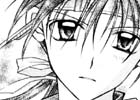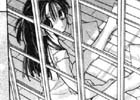Full Moon wo Sagashite by Kuzu Ryu Sen
| Japanese Title: Searching for the Full Moon | ||
| Also Known As: Fuuru Muun wo Sagashite, Mangetsu wo Sagashite, FMwS | ||
| Genre: Drama/Romance | ||
| Length: 7 Volumes | ||
| Allegiance: Shueisha | ||
| Mangaka: Tanemura Arina | ||
| Vintage: 2002-2004 | ||
| Intelligence Agency Report by: Kuzu Ryu Sen | ||
| Kouyama Mitsuki is a 12 year old girl who lives with her very strict grandmother and her maid in an old fashioned Japanese house. The reason: Mitsuki has a malignant tumour in her throat. However, surgery is out of the question for Mitsuki, for it threatens to kill her dream of becoming a singer, so she must remain home and be careful not to overexert her body or her voice. One day, everything changes when the Shinigami Combi Negi Ramen arrive bearing news that Mitsuki only has a year to live. This spurs Mitsuki into action, and she rushes desperately to the Seed Records New Artists Audition with Negi Ramen in hot pursuit. Can she achieve her dreams before her year is out, or will the immense odds stacked against her crush her childish ambition? | ||
|
|
||
| Research Agent Report by: Kuzu Ryu Sen | ||
| Plot Characters Impact Visual |
6.00 9.50 8.00 6.50 |
|
| Overall | 7.75 | |
| (not an average) | ||
| Tanemura Arina isn’t exactly a well known artist in the world of shoujo manga, with her only other prominent work being Kamikaze Kaitou Jeanne. However, Full Moon wo Sagashite has gained quite a bit of popularity, thanks to a very well crafted anime adaptation. However, the manga is drastically different, being much darker, much more serious, and having a much faster pace.
Full Moon wo Sagashite‘s plot and characterization is a definite mixed bag. On the one hand, secondary characters such as Izumi Rio, Wakamatsu Madoka, and even Jonathan get much more attention than in the anime, without too much noticeable detriment to Mitsuki, Takuto, Eichi, and company. However, the presentation is lacking, particularly in the middle volumes, where Tanemura just throws in one side story after another until the reader is enticed to forget that Mitsuki is actually the main character. Although the manga contains not a single page of filler, the pacing is frenetic, which leads to very poor transitions, introductions, with the end result being a very messy story. The dialogue is nothing overly special either, often using pointless, flowery monologues that mark the genre. Where Full Moon wo Sagashite does manage to shine though, is in the last third. Much like the anime, the manga finishes very strongly (no coincidence methinks). The organization and pacing straighten themselves out quite nicely, and the spotlight is thankfully placed back onto Mitsuki and her singing career. It doesn’t quite make up for everything that had happened before, nor does it really have the same emotional impact without audio, and it bears an uncanny similarity to the anime adaptation’s ending (which had aired a year prior). In this way, at least the reader end the story on a high note. In terms of art, Tanemura’s character designs are excellent, with great attention to detail, even if the basic face design of a lot of male characters are a tad too similar to each other. However, her backgrounds are sorely lacking, or even absent most of the time. Maybe it’s just the nature of the genre, but the massive use of shades instead of actual drawings does not good art make. In the end Full Moon wo Sagashite is by itself a pretty good read and a must for anyone who enjoyed the TV series. The serious mood and darker overtones may put off some people used to the cheery overly optimistic atmosphere of the anime, but the additional character development supplied is a must for any fan of the franchise. It’s a pity that the organization is so poor because despite a healthy dose of melodrama, Full Moon wo Sagashite really did have all the ingredients to be a fantastic story, one that even surpasses the excellent anime.
|
||




